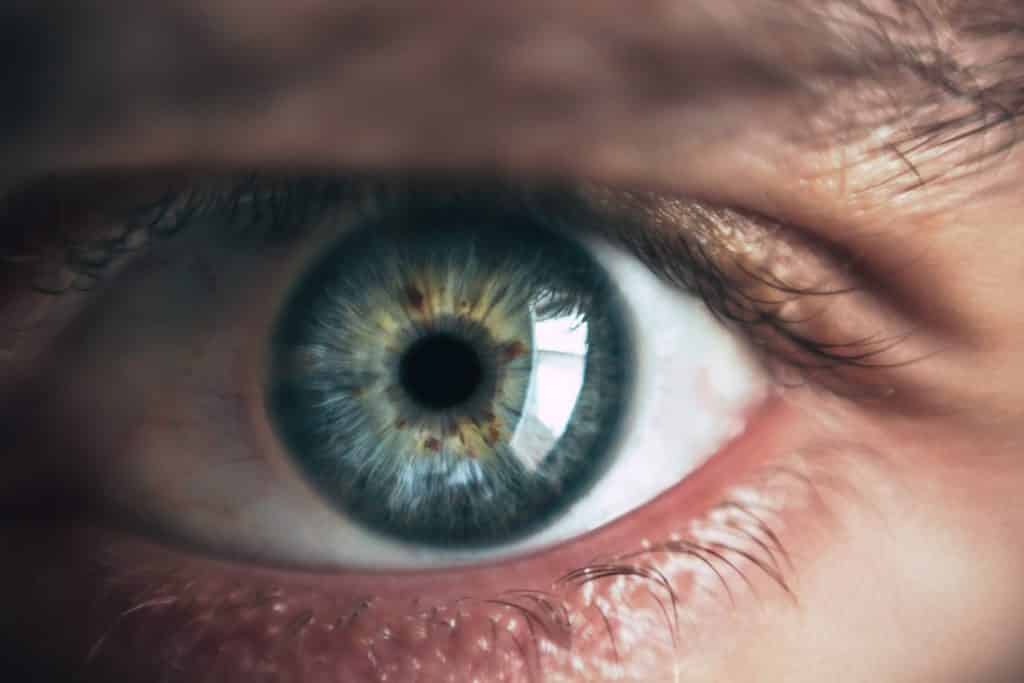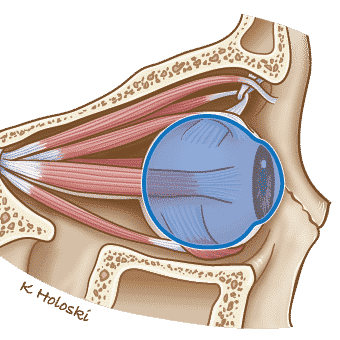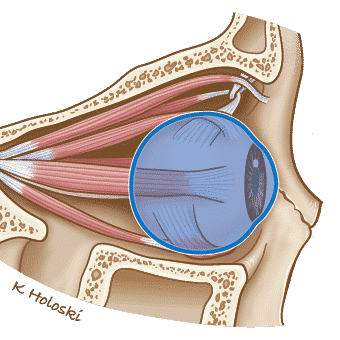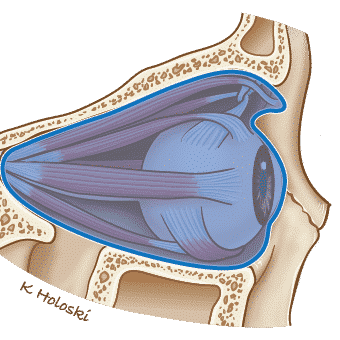The eye is a complex structure.
In the most basic sense, the orbit includes everything within the bony eye socket, including the eyelids, orbital fat, eye muscles, optic nerve, conjunctiva, and the eye itself (also referred to as the globe or the eyeball). The globe of the eye is a complex structure, but it can be simplified as an almost-spherical structure filled with a clear, jelly-like substance.
We say “almost-spherical,” because the very front of the eye contains the cornea, iris, and lens, which form a kind of bump on the surface of the eye. All around the rest of the globe of the eye, the jelly-like fluid is contained inside three layers of tissues: the sclera, the uvea, and the retina.

Eye Anatomy
The anatomy of the eye is quite complex. Learn more about orbital anatomy.
More Anatomy of the Eye
The sclera is the outermost layer, and is the white part of the eye. It makes up most of the surface area of the eyeball, and is responsible for maintaining the shape of the eyeball. Most of the eye muscles, also called the extraocular muscles, attach to the sclera and control the movement of the eye.
Each procedure listed in this section describes a slightly different extent of eye and eye socket removal, involves the removal of different anatomical structures, and is done for a different reason. Ophthalmologists perform eviscerations and enucleations, while exenterations are performed by either ophthalmologists or head and neck surgeons.
Orbital Evisceration
A head and neck surgery team will remove the inner contents of the eye, without removing the outer layer of the eyeball (known as the sclera). It should not be used for cancer treatment, but rather for infections, severe pain, or problems inside the eye that cause vision loss.

Preparing for Surgery (Pre-Surgery)
You will receive specific instructions on when you need to stop eating and drinking, and your medication regimen before surgery.
On the day of your surgery, you will arrive at the hospital a few hours before your scheduled procedure. The nurses, anesthesiologist, and head and neck surgery team will check in with you. If you have any last minute questions, this is a good time to ask them.
What to Expect from the Surgery
This procedure is performed by an eye surgeon (opthamologist). It can be completed with a regional nerve block or a small dose of anesthesia for sedation.
The surgery team will remove the inner contents of the eye, but leave behind the white outer layer of the eyeball, also known as the sclera. This procedure often involves placement of an implant inside of the sclera to keep the shape of the eyeball.
Like any surgery, the major risks are bleeding and infection. In these rare events, you may need to be treated with medication or additional surgery. A small risk of infection of the brain also exists due to the proximity between the eye and the brain.
Post Surgery Recovery & Aftercare
After the procedure, the outer appearance of the eye will stay the same. However, you will no longer have vision in the eye that is operated on. The duration of time spent in the hospital post-surgery is case-dependent, but is typically a few weeks.
Once the surgery team is confident you are ready to be discharged, a discharge planning team will work with you and your family to determine the best route forward. After discharge, additional treatment and reconstruction options can be discussed.

Download The Section Above
Feel free to download and print this section: eye evisceration.
It’s free for personal use and to share with others you think might benefit from the information provided.
Orbital Enucleation
An orbital enucleation involves the removal of the entire eyeball, including the globe and the sclera. Other orbital (eye socket) contents will stay in place. It is performed for infections, cancers within the globe of the eye, and cases of trauma to the eye.

Preparing for Surgery (Pre-Surgery)
You will receive specific instructions on when you need to stop eating and drinking, and your medication regimen before surgery.
On the day of your surgery, you will arrive at the hospital a few hours before your scheduled procedure. The nurses, anesthesiologist, and head and neck surgery team will check in with you. If you have any last minute questions, this is a good time to ask them.
What to Expect from the Surgery
This procedure is performed by an eye surgeon (opthamologist). It can be completed with a small dose of anesthesia for sedation or general anesthesia to put you to sleep. The surgery team will remove the entire eyeball, including the globe and the sclera, but leave the rest of the orbital contents in place including the extraocular muscles, lacrimal gland and optic nerve. This procedure requires the extraocular muscles to be disconnected from the sclera.
Like any surgery, the major risks are bleeding and infection. In these rare events, you may need to be treated with medication or additional surgery. A small risk of infection of the brain also exists due to the proximity between the orbital cavity and the brain.
Post Surgery Recovery & Aftercare
After the procedure, you will no longer have vision in the eye that is operated on. The duration of time spent in the hospital post-surgery is case-dependent, but is typically only a day or two.
Once the head and neck surgery team is confident you are ready to be discharged, a discharge planning team will work with you and your family to determine the best route forward. After discharge, additional treatment and reconstruction options can be discussed. This might include placing an artificial eye, which can be done a few months after your initial surgery.

Download The Section Above
Feel free to download and print this section: eye enucleation.
It’s free for personal use and to share with others you think might benefit from the information provided.
Orbital Exenteration
This is the removal of all eye socket contents, including muscles, the lacrimal gland system, the optic nerve as well as varying parts of the bone of the orbit. The eyelid can be spared, depending on the extent of the tumor. This is done for large cancers of the eye, the skin over the eye or eyelid, or cancers from other areas that extend into the eye socket. It can also be required for very bad infections, such as aggressive fungal infections.

Orbital exenteration is done under general anesthesia. Since this procedure is done for the spread of cancer into the eye socket from another location, this procedure is often done along with an associated procedure such as a maxillectomy or craniofacial resection. After the procedure, the eye socket is usually reconstructed with either a regional flap or free flap if a large defect remains.
Post Surgery Recovery & Aftercare
The recovery course will depend on the extent of the surgery and reconstruction. With some surgeries, a patient could go home after a few hours of observation in the recovery room while others might require a stay in the hospital for one to two weeks.
Once doctors determine that a patient no longer needs in-patient level care, they will be ready for discharge. While some patients can go home from the hospital with or without visiting nurses or receiving home care, others might go to a rehabilitation or skilled nursing facility for a short while before going home. The discharge planning team, which includes doctors, social workers, nurses and physical therapists, along with the patient and their family, will determine the best place for the patient to go once they’re ready to leave the hospital.
Any additional treatment or reconstruction is planned after discharge. This gives the patient time to recover from the initial surgery, get the final pathology results of the surgery, and make appropriate arrangements for next steps. Prosthetic eyes are made a few months after surgery.

Download The Section Above
Feel free to download and print this section: eye exenteration.
It’s free for personal use and to share with others you think might benefit from the information provided.
Risks
As with any procedure, there are risks in undergoing removal of the eye that patients need to be aware of. The patient will lose all vision in the affected eye in all three of these procedures. However, some other possible risks will include:
- Bleeding (including Hematoma)
If there is severe bleeding after the procedure, the surgeon might need to quickly take the patient back to the operating room to stop the bleeding. - Infection
Infections are quite rare; however, with any surgical procedure, there is always a risk of an infection after the surgery. This might require antibiotics and/or drainage of the infection. Because the orbital cavity and the eye are so intimately associated with the brain, a risk of brain infection or other problems exists.
Other risks will be associated with the additional procedures being performed, such as maxillectomy or craniofacial resection.

Top Questions for Your Doctor
Access our list of the most important questions to ask your physician at your next appointment.













